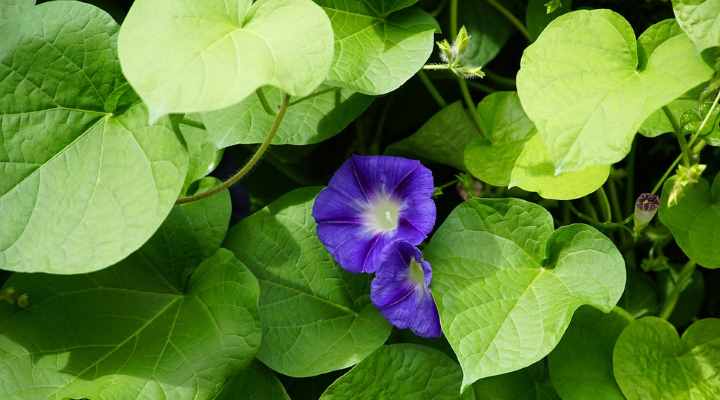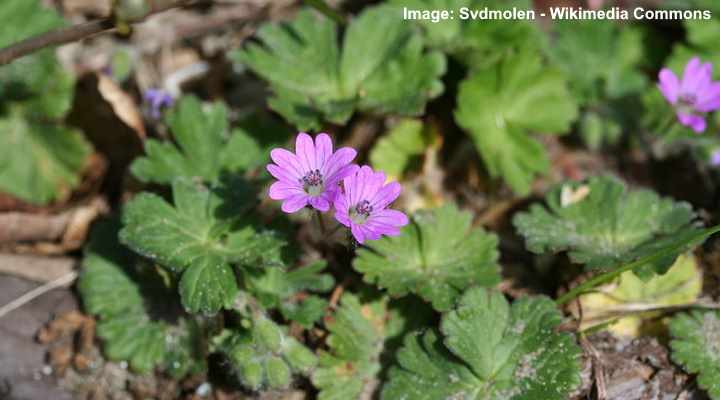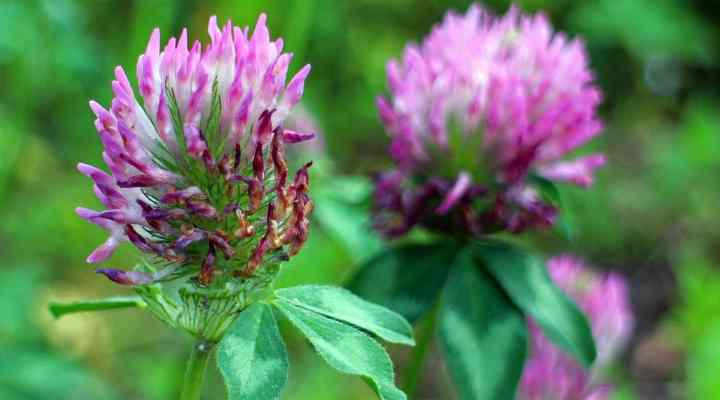Types of Purple Weeds in Grass: Identification Guide with Pictures

Purple weeds in grass can be a nuisance if you want to maintain a lush, green lawn. The pesky purple flowers in the turfgrass can detract from the beauty of your front or backyard lawn. And trying to get rid of broadleaf weeds with purple flowers can be challenging. It seems that as soon as you pull out the purple flower weeds from the grass, they emerge again a few weeks later. Also, some fast-spreading weeds seem to materialize as if from nowhere after rainfall.
Identifying types of weeds with purple flowers is key to eradicating them. For example, some pesky weeds have long taproots that are difficult to remove completely. Other difficult weeds spread through tiny seeds dispersed in the wind. And other hardy weeds have extensive roots, spreading via runners and stretching several feet in the grass.
This article identifies common weeds with purple flowers that typically affect grass and ornamental lawns. In addition to descriptions and weed identification photos of common purple flower grass plants, you will find helpful tips on reducing weeds in lawns and turfgrass front yards or backyards.
What Are Purple Weeds in Grass?
Purple weeds are invasive, often fast-spreading broadleaf plants that thrive in lawns—usually in unwanted places. Although some weeds have attractive purple flower heads, their presence in a healthy garden and lawn is often unwanted. Instead, these annoying uncultivated weeds grow in competition with healthy turf and ruin the appearance of a well-manicured lawn.
How to Identify Purple Lawn Weeds?
Knowing how to identify the types of weeds residing in grass is key to eradicating them. For example, some purple-flowering grass weeds like dead nettle have small taproots like a carrot. However, other noxious weeds have stolons or aggressively spreading shoots or roots growing in the lawn thatch. Other purple weeds spread seeds via the wind, especially after mowing the flowers.
Weeds with purple lawn weeds tend to have small lilac, lavender, or pale purple flowers. Other identification features are their leaf shape, margins on the leaves, and plant height. Also, some common spring weeds like henbit, creeping speedwell, and deadnettle appear early in the season.
How to Get Purple Weeds Out of Grass
Eliminating common purple-flowering weeds can be difficult without using weed control sprays. Unfortunately, these weed sprays can contain potentially toxic chemicals. Therefore, purple weed removal is usually best achieved by removing the weeds by hand or using natural weed control methods.
A common weed issue is that hardy, drought-tolerant plants are challenging to eliminate from grass. Therefore, weed-preventative measures are the best control strategy. For example, healthy lawn care techniques involve allowing grass to grow taller, pulling weeds by hand, or using a natural pre-emergent weed control product like corn gluten meal.
In extreme cases of a serious weed issue with annual or perennial weeds, you may have to resort to broadleaf herbicides. However, spraying chemicals in common grassy areas may leech into waterways or affect fruits and vegetables growing nearby.
Therefore many eco-aware gardeners embrace the purple flowers in the grass while taking preventative measures to stop the purple weeds from getting out of control. In addition, some weeds with creeping stems benefit some gardens—they help prevent soil erosion.
Common Lawn Weeds with Purple Flowers
Purple deadnettle and henbit are the two most common weeds to affect grass and lawns. However, depending on your location and climate, purple-flowering weeds like creeping Charlie, wild violet, and common self-heal can become problematic plants in grassy areas of your yard. Of course, these purple weeds can grow alongside white-flowering weeds.
Types of Purple Weeds in Grass (With Pictures)
Let’s look in detail at the common types of broadleaf weeds with purple flowers that invade grass plots, lawns, and turfgrass in front and backyards.
Purple Deadnettle (Lamium purpureum)

Purple deadnettle is a very common lawn weed with little pink-purple flowers growing in the grass
Purple deadnettle is fast-growing and one of the most pervasive purple flowering lawn weeds. The weedy plant is identified by its characteristic square stems, mint-like green triangular leaves with a purple tinge, and small tubular purple flowers. Purple deadnettle can be a weed problem in grassy areas from late spring onward.
Like henbit, purple deadnettle is a winter annual that forms small rosettes of leaves in the fall. The flowering plant’s vigorous growth starts in spring when purple flowers form before seeding in summer. This common garden weed can be difficult to distinguish from henbit.
Purple weed identification: Purple deadnettle is identified by upright stems topped with purple flowers and lipped petals, triangular or heart-shaped green leaves with serrated edges, and purplish-green foliage.
How to control purple weed in grass: The best way to eradicate purple deadnettle is to pull the noxious weeds out of the lawn by hand. Always ensure that you get all the roots; otherwise, it will sprout in your turfgrass the following spring.
Henbit (Lamium amplexicaule)

Henbit is a flowering weed often seen in the grass with purple-pink small flowers that are similar to purple deadnettle
Henbit is a low-growing creeping weed with purple flowers. It is an annual weed with an aggressive growth habit, which makes it tough to control. Henbit is in the mint family, like purple deadnettle. This herbaceous purple weed colonizes disturbed soil in gardens, yards, parks, and fields. This weedy lawn plant produces small pinkish-purple flowers with two-lipped petals. Henbit thrives in the shade and grows up to 1.3 ft. (0.4 m) tall.
The difference between henbit and deadnettle is that the leaves don’t have petioles on the upper part of the square stalk. However, both weeds have triangular mint-like leaves with a scalloped effect. The purple flowers bloom from March through August.
Purple weed identification: Henbit is a low growing weed that can be identified by its small, two-lipped tubular flowers and egg-shaped or heart-shaped leaves growing up to 1” (2.5 cm) long.
How to control purple weed in grass: The most effective control method for henbit is physically removing the weeds in the fall. This is when the weed is not actively growing, and you reduce the risk of spreading seeds.
Common Blue Violet (Viola papilionacea)

Common blue violet can be grown as a purple flowering ground cover but it can become a lawn weed as it is easily self-seeding
Common blue violet is a perennial shade-loving purple-flowering clumping plant with weedy growth. The purple weeds come to life in late winter, blooming with five heart-shaped purple petals. Although the purple flowers look spectacular in containers, beds, and ground cover for shade, they can destroy the appearance of a lush green lawn.
Common blue violets are sweet-smelling aromatic flowers that look stunning in the right setting. The purple-flowering plants grow 10” (25 cm) tall and spread vigorously up to 2 ft. (0.6 m) wide.
Purple weed identification: Easy to identify, common blue violets have eye-catching purple flowers measuring 0.5” (1.1 cm) across and kidney or spade-shaped leaves growing in a rosette pattern.
How to control purple weed in grass: The purple-flowering perennial weeds are difficult to control because of their tough taproot. To prevent the purple weeds from thriving, keep grass height relatively short to decrease shade. If you see young plants, pull them straight up from the ground.
Creeping Charlie (Glechoma hederacea)

Creeping Charlie is a spreading lawn weed with small purple flowers and scalloped leaves
Creeping Charlie is an aggressive and invasive purple weed common in lawn, gardens, landscapes, and shady spots. This low-growing perennial plant has rounded leaves with scalloped edges. Every spring and summer, creeping Charlie produces distinctive purple or lavender tubular flowers with spreading lobes. The spreading weed grows 1 ft. (0.3 m) tall.
This lawn pest is prevalent throughout North America. It spreads quickly through runners that root in the soil and thrives in shady and sunny conditions.
Purple weed identification: Creeping Charlie is identified by its whorls of small funnel-shaped purple or blue flowers growing on tall stems. Also called ground ivy, cat’s foot, or gill-over-the-hill, it has fuzzy leaves with scalloped edges.
How to control purple weed in grass: The only way to control purple-flowering creeping Charlie is to pull it out of the ground with a rake and remove the entire root system; otherwise, the weed will regrow.
Creeping Thistle (Cirsium arvense)

Creeping thistle is a very invasive tall weed with pale purple flowers and extensive root system
Creeping thistle is a perennial weed with a characteristic purple-pink crown of wiry petals on a spiny ball. Like most thistle plants, this variety has spiky blue-green lanceolate leaves with irregular lobes. This pesky weed can become rampant in gardens and lawns, spreading via lateral root growth and seeds.
Also called Canada thistle, this weed is difficult to eradicate when established. Thriving in most of North America, creeping thistle grows up to 4 ft. (1.2 m) tall, and its purple flowers measure 0.5” (1.13 cm) across.
Purple weed identification: Identification features of creeping thistle are its dark green spiny leaves and purple-lavender thistle-like flowers that bloom throughout summer.
How to control purple weed in grass: Physically removing the weed is the only way to control it without using herbicides.
Bull Thistle (Cirsium vulgare)

The magenta-purple flowering bull thistle is an invasive weed in some areas and can affect native plants and grass lawns
Also called the common thistle, this purple-flowering spiky weed spreads quickly in disturbed grassy areas, filling landscapes with prickly leaves and outcompeting native plants. Common thistle leaves are spiny and deeply lobed and grow 7” (18 cm) long and 2” (5 cm) wide. Clusters of magenta-pink thistle flowers grow at the end of tall, spiny stems.
This vigorous spreading noxious weed can produce up to 300 seeds from a single flowerhead, and thousands of seeds per plant can be released in a single season. Therefore, removing the first sign of a prickly leaved rosette growing on a lush lawn is crucial to stopping bull thistle weeds from spreading.
Purple weed identification: The identifying features of bull thistle weeds are their sharp, spiny lance-shaped leaves with a fuzzy covering and purple to mauve flowerheads sitting on top of spiny bracts.
How to control purple weed in grass: The best way to eliminate bull thistle weeds from a lawn is to dig up the stems 2” (5 cm) below the soil surface before it starts flowering.
Forget-Me-Nots (Myosotis sylvatica)

Forget-me-nots are identified by their tiny purple or bluish flowers with yellow centers. They can grow uncontrollably and become a lawn weed
Forget-me-not is a lawn weed with purple flowers that grow in some Midwestern states. The aggressive self-seeding plant has beautiful five-petalled purple or pale blue flowers with yellow centers. Forget-me-nots have oblong-linear leaves with a hairy surface. Due to its uncontrolled vigorous growth, the ground-hugging annual plant has weedy tendencies.
Forget-me-nots grow 12” (30 cm) tall and 10” (25 cm) wide. In areas where the delicate purple flowers are not invasive, you can grow the spreading plant in full sun or partial shade under shrubs, in mixed beds, or containers.
Purple weed identification: The identifying features of forget-me-nots are their charming light blue or purple flowers growing in dense clusters in spring and summer.
How to control purple weed in grass: To ensure that forget-me-nots don’t take over your lawn, remove the flowerheads as soon as they bloom. Additionally, you can easily pull up pesky grass weeds from moist soil. Therefore, watering the lawn before weed removal can be effective.
Musk Thistle (Carduus nutans)

Musk thistle is a common weed with prickly leaves, purple-pink flower head and tall growth habit
Musk thistle, also called nodding thistle, is an herbaceous lawn weed prevalent throughout most North America. The long, purple-flowering weed grows up to 6 ft. (1.8 m) tall from spiky leaves growing in a rosette arrangement up to 2 ft. (0.6 m) in diameter. When the purple flowers mature, they droop to a 90°-angle and seem to nod in the wind.
Musk thistle can cause unsightly growths in your lawn. The weeds generally spread via seed dispersal; therefore, removing them before blooming is crucial to prevent an invasion of weeds on your lawn.
Purple weed identification: Identification features of musk thistles are their sharp, spiny lance-shaped leaves with a fuzzy covering and purple to mauve thistle-like flowerheads sitting on top of spiny bracts.
How to control purple weed in grass: Pulling musk thistles out of the ground by hand is the most effective control method. You can use a thistle weed extractor to remove as much of the taproot as possible.
Healall / Common Self-Heal (Prunella vulgaris)

Common self-heal is a ground cover perennial weed with purple flower spikes that grows vigorously and can become a weed in the grass
Self-heal is a vigorous lawn weed with lavender-purple flowers that grow around 1 ft. (0.3 m) tall, creating a dense flower spikes. Also called healall, this weedy purple-flowering plant spreads through grass plots and lawns and has long stems. The weed’s leaves are egg-shaped with slightly wavy edges.
This herbaceous weedy plant typically thrives in full sun; therefore, letting turfgrass grow longer to create shade at the soil level can help prevent the purple flowers from taking over your lush lawn.
Purple weed identification: Healall is identified by its purple or white flowers growing on cylinder-shaped flowerheads. Additionally, its shiny egg-shaped leaves measure 4” (10 cm) long and have a grayish-silver green tinge.
How to control purple weed in grass: To get rid of this tenacious purple weed from your lawn, dig it out with a hori hori weeding tool or a small trowel.
Creeping Speedwell (Veronica repens)

Creeping speedwell spreads quickly and can become invasive weed in the grass
Creeping speedwell is a low-growing weed that can wreak havoc on a beautiful lawn due to its rapid growth nature. The low-growing nature of creeping speedwell makes it tough to remove by mowing. This invasive grass weed creates a carpet of small four-petalled lavender to white flowers and tiny green leaves forming thick mats in turfgrass.
Creeping speedwell grows 1” to 3” (2.5 – 7.5 cm) tall and up to 12” (30 cm) wide. Although it’s an excellent plant for fast-growing ground cover, the weedy purple flowers can become a serious nuisance in sunny lawns.
Related reading: Ground cover plants with purple flowers.
Purple weed identification: Identifying features of weedy creeping speedwell are its dainty pale purple flowers contrasting against bright green foliage growing on creeping stems.
How to control purple weed in grass: Good lawn maintenance is the best preventative treatment for treating creeping speedwell weeds. This includes a regular watering schedule, organic lawn fertilization, and mowing to the correct height. Densely growing turfgrass chokes speedwell and many other common lawn weeds.
Morning Glory (Ipomoea purpurea)

The fast growing purple flowering morning glory vines can spread quickly in the grass and become a lawn weed
Morning glory can become a fast-growing lawn weed featuring vibrant purple, trumpet-shaped flowers. In addition, because morning glory is self-seeding, it can become an invasive lawn plant. This trailing or twining trellis plant can easily become a weedy nuisance in lawn gardens, especially in warm, humid climates.
Of course, morning glory has several landscaping uses as an annual trailing plant or purple-flowering climbing plant. However, the fast-growing spreading plant can impact a lawn’s appearance if it roots in turfgrass.
Purple weed identification: Morning glory is identified by its green, heart-shaped leaves, showy trumpet-like purple flowers, and spreading nature.
How to control purple weed in grass: The best way to remove purple-flowering weeds naturally, like morning glory, is to remove the spreading stems by hand.
Dove’s-Foot Crane’s-Bill (Geranium molle)

Dove’s-foot crane’s-bill is a fast spreading weed with small purple-pink flowers and palmate leaves
Dove’s-foot crane’s-bill is a pesky annual weed with distinctive purple-pinkish flowers that invades lawns and grassy areas. The fast-spreading purple-flowering weed becomes invasive as its seed pods burst and throw seeds several inches, even several feet, away from the plant. In dry conditions and poorly cared-for lawns, this geranium plant spreads quickly, making it difficult to control.
The good news is that this weed can be eliminated from your lawn or garden with proper management. The best preventative action is to improve lawn care and ensure that turfgrass is moist, well-fertilized, and mowed to the correct height.
Purple weed identification: Identifying features of dove’s-foot crane’s-bill are its distinctive palmate leaves with up to nine shallow lobes, pinkish-purple flowers 0.4” (1 cm) in diameter, and blooming time from late April to early fall.
How to control purple weed in grass: Like controlling the most invasive purple-flowering grass weeds, cutting or pulling the noxious plants before they bloom is the most effective natural weed control method.
Purple Clover (Trifolium pratense)

Purple clover (Trifolium pratense) is a low-growing purple spreading lawn weed with purplish-pink flowers
Purple clover is a common low-growing lawn weed with purplish-pink flowers. The purple spreading lawn weed has slender stalks, small oblong leaves, and purple-pink rounded flowers. The weedy plant can spoil the appearance of lawns due to its clumping nature, purple flowers, and fuzzy broadleaves.
Purple weed identification: purple clover can be identified by its purplish-pinkish flowers, and green leaves consisting of three leaflets.
How to control purple weed in grass: One of the best ways to control purple flowering clover in a lawn is to keep a healthy lawn. You can also remove clover from a lawn with a rake by pulling up its creeping stems. In addition, setting your lawnmower to leave the grass a little longer can help prevent clover from growing in lawns.
Related articles:
